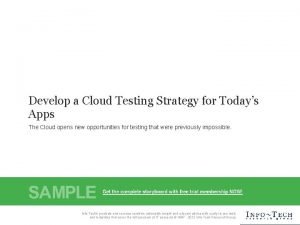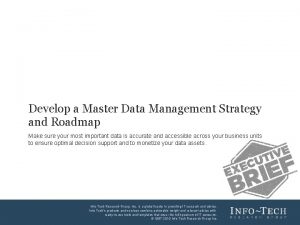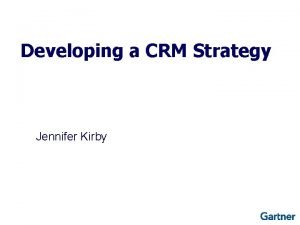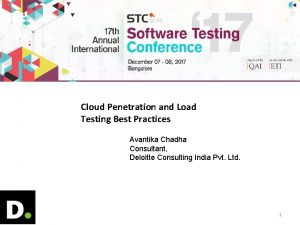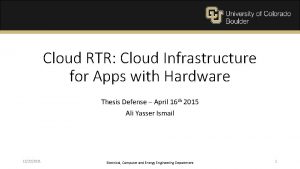Develop a Cloud Testing Strategy for Todays Apps












- Slides: 12

Develop a Cloud Testing Strategy for Today’s Apps The Cloud opens new opportunities for testing that were previously impossible. Info-Tech Research Group, Inc. Is a global leader in providing IT research and advice. Info-Tech’s products and services combine actionable insight and relevant advice with Info-Tech's products and services combine actionable insight advice ready-to-use tools and templates that cover theand fullrelevant spectrum of IT with concerns. and templates that cover the full spectrum©of 1997 -2012 IT concerns. © 1997 -Research 2012 Info-Tech Group Research Inc. Info-Tech Research Group 1

Introduction Organizations are finding it difficult to execute test cases and monitor performance of a new breed of cloud applications. Leverage cloud testing to augment traditional practices and open the door to a higher level of software testing. This Research Is Designed For: This Research Will Help You: üOrganizations that are refining testing üRealize the changes of the software testing life methodologies and protocols to encompass cloud technology. üApplication Testing Managers responsible for cycle with the introduction of cloud technology. üShow you how the Cloud can significantly expand your testing capabilities. setting a standardized testing strategy. üSoftware Developers tasked with testing small üUnderstand the costs and benefits of cloud testing. units of newly written code. üQuality Assurance Managers looking to üDevelop a standardized approach to testing in the Cloud. streamline QA processes. Info-Tech Research Group 2

Follow the Info-Tech Software Testing Roadmap Develop and Improve a Software Testing Strategy • Develop a Cloud Testing Strategy for Today’s Apps You are Here! • Traditional software testing processes provide a concrete foundation when developing and standardizing your software testing strategy. • This solution set will provide insight into how to incorporate cloud technology into your current software testing strategy. Learn how to align cloud testing initiatives with the development and traditional testing workflow. Assess the Appropriateness of Automated Functional Testing • Automating functional testing can improve software quality for the right shop, but the cost of automation tools and ongoing maintenance can outweigh the benefits. Vendor Landscape Plus: Tools for Functional Testing Automation • Testing Strategy There are dozens of tools out there that can automate functional testing. Select the right tool by understanding the features and requirements associated with functional testing tools. Vendor Landscape: Software Test Management • Gain insight into which vendor best aligns with your organization’s needs and which Software Test Management solution will provide the most efficiency within your infrastructure. Info-Tech Research Group 3

Executive Summary The reality of today’s complex web and cloud applications demands a new approach to testing. • Increasingly connected apps using the Cloud at the back end along with highly fragmented endpoints at the front end make traditional combinatorial testing almost impossible to execute; there are simply too many options. • Traditional load and stress testing scaled down, simulated production environments, and forecasting the break point doesn’t hold with cloud virtualization and scalability. The focus on load and test needs to be done in the Cloud with scale if testing is to be reliable. • Today’s increasingly global apps requires a global test lab with custom stacks. The Cloud offers a cost effective means to achieve this. Your rollout strategy needs to be in three phases. • Business Case: Align cloud testing strategy and execution in order to ensure both the implementation and metrics are of value to the business. • Implementation: Thankfully much of the testing and development process remains the same. Organizations need a good vendor with a toolset aligned along the business strategy, and solid knowledge of the Cloud to help the implementation go smoothly. • Metrics: Organizations need to measure testing metrics before and after cloud testing is rolled out. The ability to parallelize tests in volume with low cost can add considerable return on the investment. Get cloud testing into your testing portfolio mix and start reaping the benefits. • Innovation is occurring in the young cloud testing domain. This includes such features as the ability to test gestures for multiple touch devices – something almost impossible to achieve in volume for a broad array of devices. • Cloud testing vendors are eager to gain market share in this young business model. This gives organizations a high degree of service as cloud testing vendors compete for revenue. Info-Tech Research Group 4

Testing should be where applications are hosted: in the Cloud As more applications move to the Cloud, testing with a limiting on-premise toolset introduces risk. Challenges? • Today’s applications are hosted on the web or moving towards the Cloud. Organizations require a new framework around testing cloud applications that account for on-demand scalability and self provisioning. • Expectations of application consumers (whether desktop, mobile, or touch) are continually increasing with speed-to-market and quality being the norm. • Applications reside in different locations – on-premise, private cloud, public cloud, and hybrid cloud options – and testing against such diverse deployments requires reach and scale. • Even if vendors have a cloud testing product, migrating would mean added costs of reconstructing existing test cases. Opportunities! • With cloud testing services, organizations can now more accurately represent a production environment by deploying scalable infrastructure components and application stacks cost effectively. • Long running tests can now be shortened by using cloud testing services to fan out a scalable number of functional testing units on demand during testing and executing in parallel. You need a lot servers to be able to simulate load. Cloud computing gave us access, availability, and affordability to lots of servers around the world to simulate that load. - Tom Lounibos, President & CEO, SOASTA Info-Tech Research Group 5

Adopt cloud testing or risk releasing defective applications due to budget constraints Traditional testing is costly and time consuming. Remove these burdens with a cloud testing solution. Issues with Traditional Testing • Physical machines restrict the number of replicable test labs. • This contributes to high capital costs when a large number of testing labs are needed. • Mobile introduces functionalities, tools, and applications that testing teams are not prepared for with existing tools. • Organizations are caught off guard by the growth of multiple platforms, particularly mobile. • Tests are conducted on-premise in a closed environment with limited access. • Off-shore locations are required to conduct their own tests locally, even if systems are identical. Cloud Testing Solution Scale on Demand Benefits from Cloud Testing • Systems can be scaled to a high factor at a low operational cost. Multiple Form Factors • Cloud testing solutions are compatible with multiple form factors. Globalization • The Cloud enables accessible testing assets globally at any time. Cloud technology does not change the traditional testing processes that many organizations have accepted and adopted. It does, however, enhance traditional practices with increased replication capacity, execution speed, and compatibility through its virtual infrastructure and automated processes. For more information about traditional testing, refer to Info-Tech’s Develop and Improve Your Software Testing Strategy. Info-Tech Research Group 6

Leverage the benefits of cloud testing and avoid being stuck with traditional testing limitations Cloud testing offers two unique capabilities that are difficult to replicate with traditional testing: virtualization and compatibility with cloud services. Virtualization is the foundation for automated, on-demand, and elastic testing. Organizations can: • Create custom test labs, of both in-scope and out-of-scope systems, for various technology stacks through virtual machines and service virtualization. • Closely replicate production environments. Traditional test labs were restricted to scaled versions for capital expense. • Parallelize testing through creations of multiple test labs running concurrently such that each lab is focused on a subset of use cases. Compatibility with Cloud Services Cloud testing is compatible with today’s web and cloud paradigm. Cloud testing can reside: • • In a public Cloud and spread globally to provide a more accurate picture of load testing. In a private Cloud with access to internal resources and capability to test software-as-aservice (Saa. S) cloud services in the public Cloud. Info-Tech Research Group 7

Use cloud testing to handle test cases for cloud or web apps and avoid incomplete test runs caused by scalability barriers Cloud testing offers better options for tests that depend on scale and automation. • Cloud technology has shone a new light onto traditional software testing strategies, enabling a number of unseen testing activities, such as: ◦ ◦ Cloud testing offers a new testing avenue for certain tests. High quality testing environments. Parallel development and testing capabilities. Development Cloud Develop Test Case • Physical testing labs are replaced by virtual ones that can be scaled n-times. Testing Design Fail Code • Testers are no longer required to make individual configurations to the testing infrastructure due to the Cloud’s automated process. Volatility is minimized. • Stubbing is a practice of the past. Dependent systems are virtualized and replicated at a high degree of accuracy. Traditional Testing Requirements Test Execution Test Eval. Succeed Fail Deployment: UAT/SMOKE Maintenance Code Test Execution Test Eval. Succeed Source: Info-Tech Research Group 8

Integrate cloud testing into your current development lifecycle to strengthen quality The only impact to your software development life cycle (SDLC) is within testing. The process for development and lower level unit and integration testing remain intact. 1. Requirements 2. Design Software Development Life Cycle (SDLC) 6. Maintain Each stage before testing remains the same. Functional, load, and stress testing is forked to the cloud while other test processes remain as is. 3. Build 4. Test 5. Deploy Development Workflow Source: Info-Tech Research Group 9

Manage current technology trends through cloud testing to avoid stretching timelines or compromising test results Fr ag De m vic en e ta tio n t en as Ti ing m C e yc D ec re nm ro ns tio Cloud (public and private) rather than client/server. a ic • Handle applications hosted on the web and in the pl Ap devices. ud • Be elastic to scale up/down test clients. • Accommodate test labs with unique stacks for multiple Testing & Development lo C Organizations need to adapt to these changes because current testing processes are limited. Today’s cloud testing needs to: vi • Data centers are now hosted and stored in the Cloud. • Development times are shorter. En employee supplied through bring-your-own-device (BYOD). tic • Fixed infrastructure is now elastic. • Mandated and organization-issued devices are now as El The application development and testing models are changing: le Cloud applications introduce new capabilities around JIT scalability and global reach. Your testing practices need to account for these new capabilities in light of recent trends. • Be available on-demand. Info-Tech Research Group 10

Develop a cloud testing strategy and avoid being left with buggy applications for the modern era Follow a step by step process to ensure cloud testing satisfies the required business and IT goals. Traditional testing alone is no longer sufficient for modern applications. Cloud testing fills the gap. 1. Build a Business Case Cloud testing requires new thought patterns to handle modern web and cloud integrated apps. 2. Implement Cloud Testing Create metrics to measure the success of your cloud testing efforts. 3. Focus on the Metrics Follow this diagram to navigate your way through the storyboard. Info-Tech Research Group 11

Info-Tech Research Group Helps IT Professionals To: ü ü ü Quickly get up to speed with new technologies ü Manage business expectations ü Justify IT spending and prove the value of IT ü Train IT staff and effectively manage an IT department Make the right technology purchasing decisions – fast Deliver critical IT projects, on time and within budget Sign up for free trial membership to get practical solutions for your IT challenges • “Info-Tech helps me to be proactive instead of reactive – a cardinal rule in a stable and leading edge IT environment. - ARCS Commercial Mortgage Co. , LP Toll Free: 1 -888 -670 -8889 www. infotech. com Info-Tech Research Group 12
 Consumer apps vs enterprise apps
Consumer apps vs enterprise apps Cloud application testing strategy
Cloud application testing strategy Guided, stochastic model-based gui testing of android apps
Guided, stochastic model-based gui testing of android apps Mdm strategy roadmap
Mdm strategy roadmap Crm vision examples
Crm vision examples The cloud in cloud computing refers to
The cloud in cloud computing refers to Cloud integration patterns
Cloud integration patterns Public cloud vs private cloud cost analysis
Public cloud vs private cloud cost analysis Lepsnap
Lepsnap Cloud performance testing best practices
Cloud performance testing best practices Domain testing in software testing
Domain testing in software testing Logic based testing in software testing
Logic based testing in software testing Data flow testing strategies in software testing
Data flow testing strategies in software testing

